
So you want to learn about Olympic lifting?
I get it!
I could use a gold medal hanging off my wall too.
I kid, I kid.
Even if you don’t have plans on competing, performing the Olympic lifts can be a great way to build strength and power. It’s why we teach them in our Online Coaching Program for those that are interested.
And you DON’T even need a barbell or dumbbell to get started.
Here’s what we’ll cover today:
- What are the Olympic lifts?
- What’s the difference between Olympic lifting and Powerlifting?
- What are the benefits of performing the Olympic lifts?
- Is Olympic lifting safe?
- 5 exercises to learn Olympic lifting techniques.
- When to train with Olympic lifts.
- Want to progress further? (Next Steps)
Let’s do this!
What are the Olympic Lifts?
In the video above, I show you exactly how to start performing Olympic lifts (even if you don’t have any equipment).
This may bring up a question:
What the heck are the Olympic lifts?
Olympic lifting aka Weightlifting (all one word) is a sport where athletes train and compete in the snatch and the clean & jerk.
We’ll cover variations that can be done with dumbbells (or even soup cans!) then explain how to progress up to barbells. Either way, the basic techniques will remain the same.
OLYMPIC LIFT #1: THE SNATCH

The Snatch is where the athlete grabs the bar with a wide grip, then lifts it from the ground to overhead in one strong motion.
This is a HUGE simplification of a very technical lift, but it gives us a quick definition and lets us identify the exercise when we see it.
OLYMPIC LIFT #2: THE CLEAN & JERK

The Clean & Jerk is two movements done back to back in competition:
- The Clean – ground to shoulders
- The Jerk – shoulders to overhead
Let’s break both of these down a little.
The Clean:

The clean is where the athlete grabs the bar with a grip slightly wider than shoulder-width grip, then lifts it from the ground to the front of their shoulders.
If you’re interested in performing the clean, getting comfortable with the front squat will help your technique.
We have a great video about it here:
The Jerk:

The clean may be performed by itself in training, but in competition the athlete must follow up the clean with a jerk.
And not like that…
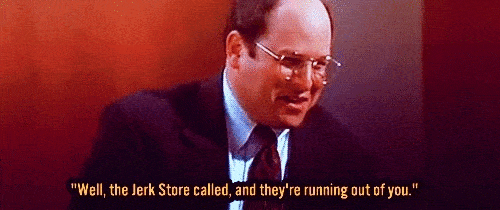

The jerk gets the bar from the shoulders to overhead and completes the lift.
You’ll often see the athlete take a staggered stance when they get the bar overhead, in order to increase stability, like so:


The difference between the two Olympic lifts comes down to the number of movements:
- The snatch is one movement: ground to overhead.
- The clean & jerk is two movements: ground to shoulders, then shoulders to overhead.
For both Olympic lifts (the snatch and the clean & jerk), the athlete must hold the weight steady with their feet underneath themselves until a judge gives them the command to drop the weight.
Basic Technique for Olympic Lifts
The basic technique for all the lifts is to explode upwards with your entire body, then quickly change direction to get underneath the weight.
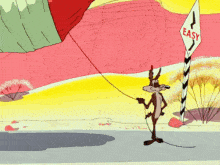

I promise we’ll get under the weight safer than that.
This is the same concept whether you’re lifting 5 lbs or 500 lbs.
(Oh also – weightlifting is normally discussed in kilos – so whether you’re lifting 2.5 kg to 227 kg!)
If the thought of exploding upwards and quickly changing directions seems odd, we also do this every time we box jump!


There’s an explosion upwards, then a quick change in direction for the legs in order to get underneath the body and up on the box.
We cover the ins and outs of performing box jumps in this video:
This is also why some will describe the Olympic lifts as “jumping with weights”.
Again, as always, a huge simplification but it gets your mind around them a bit more!
What’s the Difference Between Olympic Lifting and Powerlifting?


Olympic lifting is NOT powerlifting – a term you may have heard before.
Powerlifting is training and competing in the three lifts:
#1) The squat:


#2) The bench:


#3) The deadlift:


In both Olympic lifting and Powerlifting, we’re trying to lift the most amount of weight. It’s just that the lifts are completely different.
We’ve got a great article on powerlifting from Coach Staci if you are interested in that too!
What Are the Benefits of Performing Olympic Lifts?


Olympic lifting is often described as “gymnastics with weights.”
Athletes perform fast, powerful lifts that seem to display superhero levels of strength.
According to this review from the British Journal of Sports Medicine, Olympic lifting improves one’s vertical jump.[1]
But you don’t need a study to tell you that. Just watch some Olympians jump!
Like this:
Or check out the jumps from this team:
Even if you’re not interested in improving your dunking skills, the Olympic lifts will still build plenty of strength and coordination while providing a lot of fun variety in your training.
Is Olympic Lifting Safe?


When you see these fast, powerful movements you might immediately think these exercises are dangerous.
However, the movements are quite controlled and predictable. As opposed to pick-up sports which are inherently unpredictable.
In addition, just like any exercise, one would start light and build up slowly to maximal weights.
A study out of the U.K. from Brian P. Hamill actually shows that within 100 hours of participation, weightlifting incurs the lowest injury rates at only 0.0017 injuries during that time.[2]
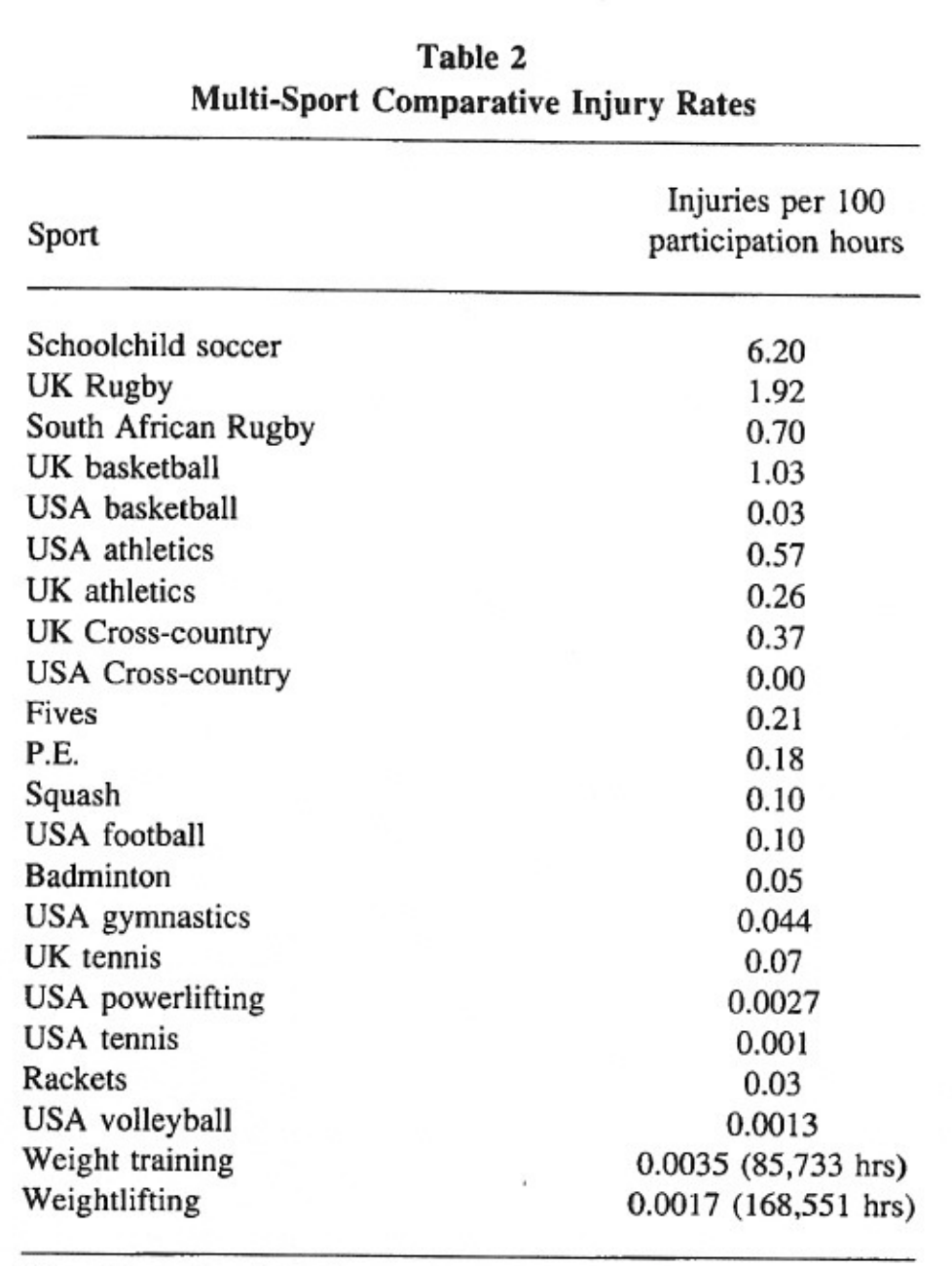

Weighting lifting is safer than badminton!?!
This is as opposed to schoolyard soccer which incurs a rate of 6.20 injuries during that same time, yet we think nothing of letting a kid kick around a soccer ball with friends.
5 Exercises to learn Olympic Lifting Technique


Let’s cover 5 exercises that will help you conquer the Olympic lifts.
#1) The Pop and Drop


So if you recall, the basic technique for all the Olympic lifts is exploding upwards, then quickly changing direction.
We’ll work on that with a drill we’ll call “pop and drop.”
Olympic lifting Coach Don McCauley has taught this as the “dirty dancing” drill too, but because we didn’t want to omit or misrepresent any cues from his original drill, we’ll simply call it the “pop and drop.”
This drill starts with something called the power position.


No, not that power position!
This power position:
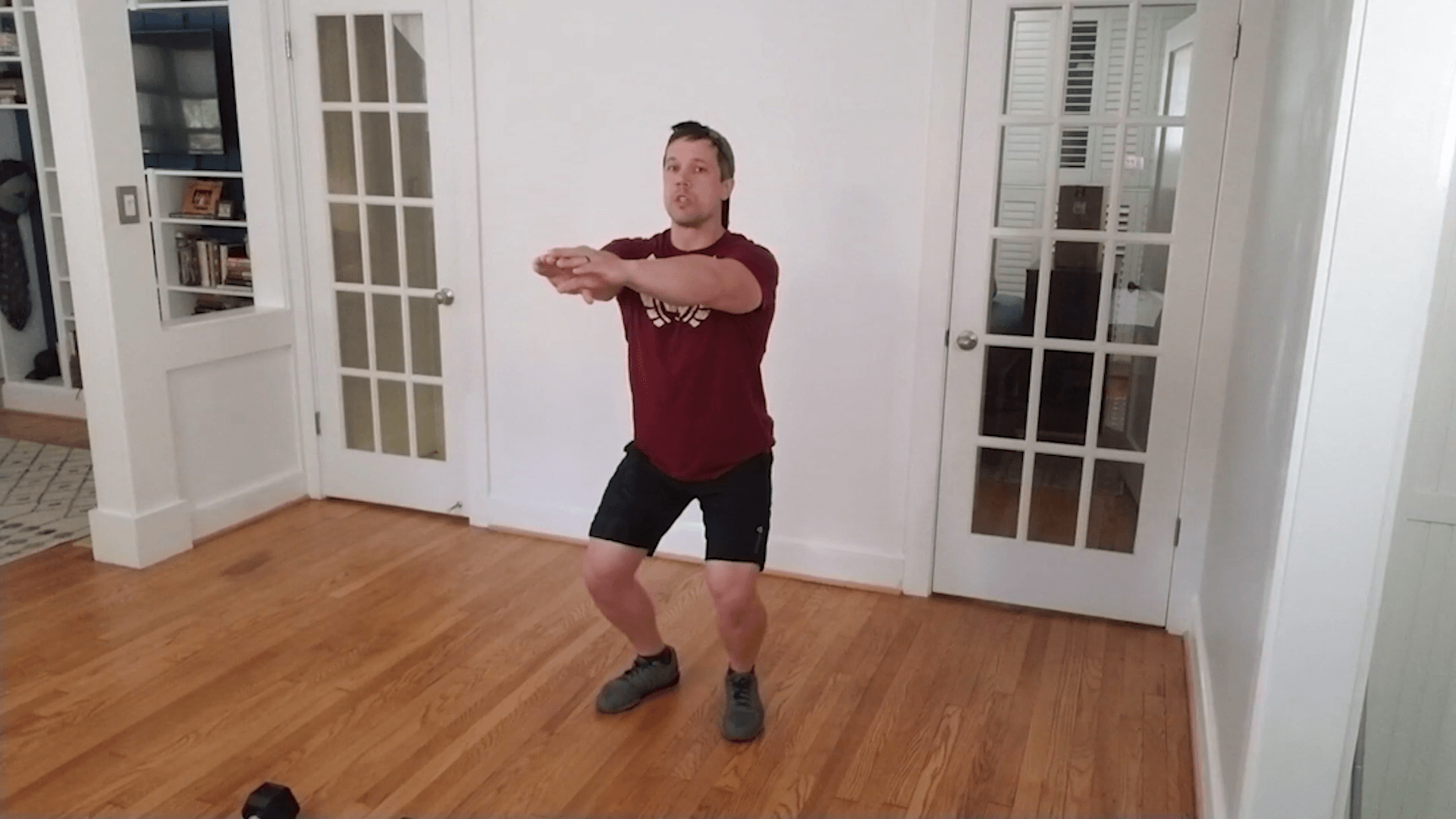

After a few warm-up squats, here’s how to get into the power position:
- Get your feet closer together so that they’re hip-width underneath you. Just think of the same width as if you were about to jump as high as you could.
- Once your feet are set, bend the knees slightly and sink your weight down a few inches.
- You still want your feet flat on the ground, and your weight balanced throughout the foot.
- You can lift your hands up in front of you for balance.
Think of this position like a loaded spring ready to be released.


You’ll see this same position in the snatch, the clean, and the jerk exercises we’ll do later.
For the “pop and drop”, once you’re in the power position you’ll then explode upwards, quickly shuffle your feet out to squat width, and drop down into a squat. Like so:


Once you’ve popped and dropped – then stand up, get your feet back underneath you, get set into the power position, and try it again!
You’ll notice that while we are exploding, we are *not* trying to jump as high as we can. This would not allow us to have a quick change in direction.
There is a RHYTHM to this exercise: the quick upwards movement followed immediately by the quick squat.
Feel it, practice it, get comfortable with it!
#2) Dumbbell Snatch


We’re going to take that basic concept of popping and dropping to an exercise called the dumbbell snatch.
Now, the end of a regular barbell snatch has the athlete catching the barbell in a squat with arms wide overhead:
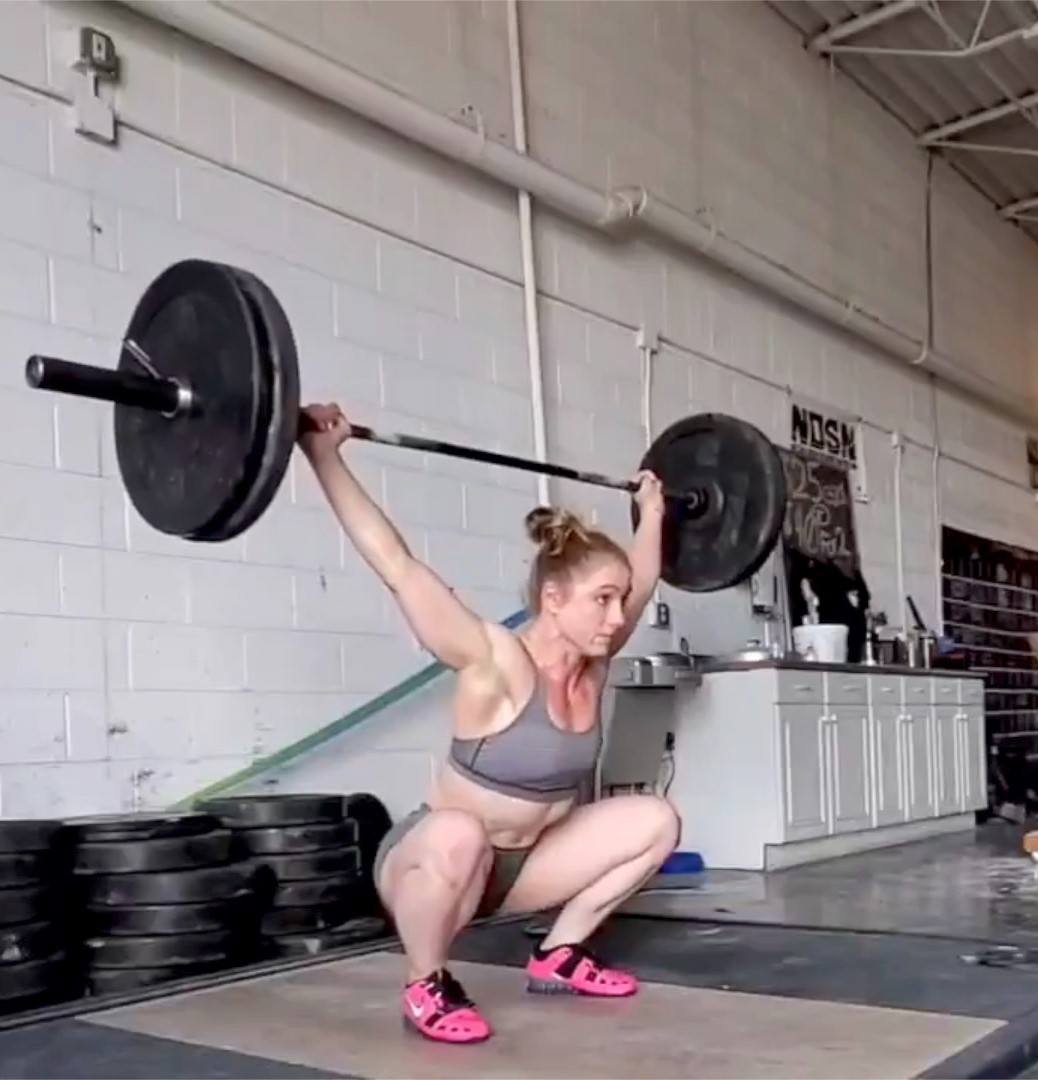
For the dumbbell snatch, we’ll be catching the dumbbell in a squat with one arm overhead:


Give this squat a go right now – with or without weight – lift your arm overhead and squat five times on each side. Go as low as you feel comfortable – you do not have to go as low as you might normally go in a regular squat.
Next, let’s practice the explosive dumbbell snatch exercise without weight in slow motion:


To perform this beginner snatch variation:
- You’ll start in the power position (there it is!), hand in front of the body. Then stand tall and extend upwards as you continue moving that hand up in front of you.
- Once your hand gets overhead, move your feet out a little wider and squat down as you straighten your arm out.
- Do the squat and the arm straightening at the same time. This will be our “quick change of direction” when we do the movement at full speed.
- Once you’ve extended the arm, then stand up to complete the lift.
When that feels good, practice the movement without weight at regular speed. Pop and drop!
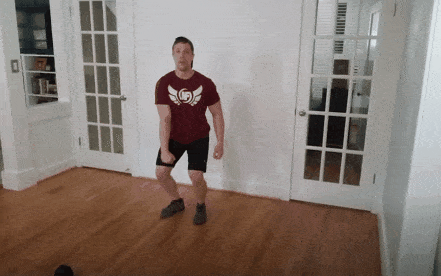

And when that feels good – add some weight! It doesn’t have to be much (could even be a soup can).


#3) Dumbbell Clean


At the end of a regular barbell clean, we have the barbell up on the front of the athlete’s shoulders.


For the dumbbell clean, we’ll be catching the dumbbells in front of the shoulders in the dumbbell front squat position.


Lift up your dumbbells to this position and give this squat a go right now for five reps. Go as low as you feel comfortable.
We’ll follow the same progression as the dumbbell snatch, so let’s practice the movement without weight, in slow motion first (Zack Synder style).


To perform this beginner clean variation:
- You’ll start in the power position (again!), hands by your side. Then stand tall and extend upwards, continuing to move the hands right up by your side.
- Once your hands get around chest/shoulder height, move your feet out a little wider and squat down as you drive your elbows down and under your hands (so your forearms are vertical).
- Squat down and drive the elbows into position at the same time. This will be our “quick change of direction” when we do the movement at full speed.
- Once you’ve gotten the elbows into position, then stand up to complete the lift.
When that feels good, practice the movement without weight at regular speed. Pop and drop!
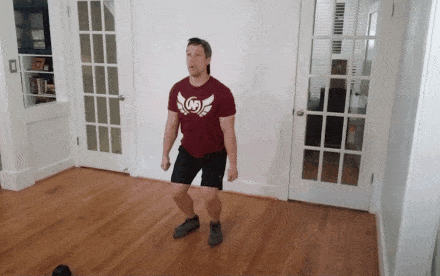

And when you have that dialed in – as before – add some weight!
Again, it doesn’t have to be much. Look for a strong, smooth movement!
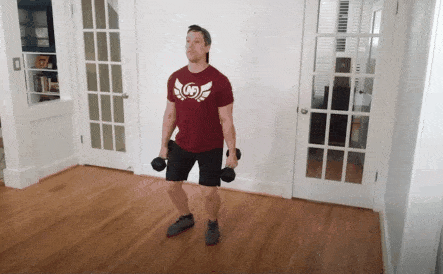

#4) Dumbbell Jerk
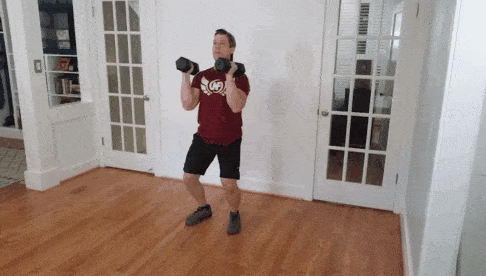

We have learned SO much so far. You’re doing awesome.
It’s time for us to learn the dumbbell jerk.
Now, the end of a regular barbell jerk doesn’t usually end in a squat…although there are athletes that do that:
The athlete is usually landing in a staggered stance, like so:



For the dumbbell jerk, we’ll drop into the same staggered stance, with dumbbells overhead.
But first, let’s try just getting the leg position right:


When you start to feel good with your leg position, get your arms involved like so:


To perform this beginner jerk variation:
- Step forward a bit with one foot, then back a bit with the other until you are in a high lunge position. Raise your arms overhead.
- Make sure your feet are wide enough – we don’t want to be standing with feet in line like we’re walking on a tightrope!
- Start off in the power position (again!) with hands right in front of your chest (they won’t move here).
- Then pop upwards and split your feet out to that stable end position. That leg movement is our “quick change of direction” that we’ll use for the rest of the jerk variations.
- Once you’ve landed in a strong split position, then step your legs back underneath you to complete the movement.
And when that feels good – just like before, add some weight:


#4) Dumbbell Clean & Jerk


Time to go for the gold and combine these two movements – the dumbbell clean and the dumbbell jerk. If you’ve made it this far, I know you can finish.
Here’s how to perform the clean & jerk with dumbbells:
- Grab the dumbbells by your side and get into the power position.
- Pop and drop into your dumbbell front squat (you’ve just cleaned the weight!)
- Now stand up from the clean and get your feet underneath you.
- Dip down through the power position, explode upwards, and jerk that weight overhead.
- Keep the weight locked out strong overhead as you get your feet underneath you!
That’s the dumbbell clean and jerk!
When to Train With Olympic Lifts


Because Olympics lifts (and the variations covered here) are technical and require you to explode powerfully, they are best done near the start of your workout when you’re first learning them.
When you train with Olympic lifts:
- Warm-up with about 10 bodyweight squats.
- Work on sets with 1-5 reps.
- Allow several minutes of rest between sets to help recover and solidify good technique.
- After you’ve prioritized your Olympic lifts, you may move onto other strong but relatively less technical lifts like squats, deadlifts, push-ups, and chin-ups.
Once you’ve developed some proficiency, you could also do some Olympic lifts with lower weight, higher reps (10 reps+) at the end of your workout as a conditioning exercise.
For more here, check out our guide How to Build Your Own Workout (for the Gym or Your Home).
Want to Progress Further? (Next Steps)


Have we whet your appetite for the Olympic lifts?
Well, the next step would be to get a coach!
Getting a coach in person would be ideal, to be able to watch your technique time and time again. But we understand that’s not necessarily possible for everyone (here’s how to hire a personal trainer if you do go that route).
If you are unable to find a coach in person, check out Nerd Fitness Online Coaching – where you’ll exchange videos with a qualified coach who can help you, no matter where you are and what equipment you have.
Ready to progress up to a barbell?
Then check out these great tutorials on Olympic lifts:
#1) How to Do a Barbell Clean:
#2) How to Do a Barbell Snatch:
#3) How to Do a Barbell Jerk:
California Strength crushed these three videos.
Alright, I think that about does it for our guide.
Now, your turn:
- How did these exercises feel?
- Are you excited to integrate Olympic lifting into your training?
- Any tips for a beginner we missed?
Let me know in the comments!
For the Rebellion!
-Coach Jim
PS: Have fun with the Olympic lifts! Start off with lighter weights so you don’t get too intimidated.
###
Photo source: Olympic rings, cetkauskas © 123RF.com, alohaflaminggo © 123RF.com, Sorry but I really can´t see anything in your radiography, man lifting barbell in gym, Day 2 Weightlifting (16 Aug 2010)


